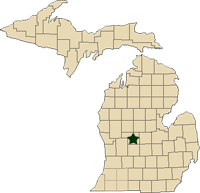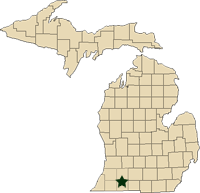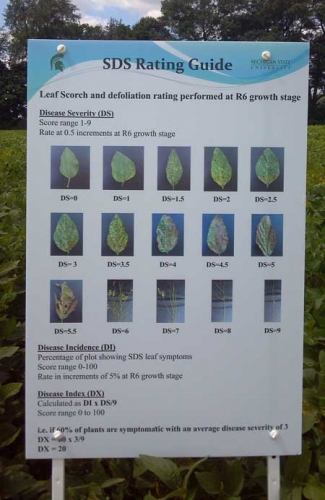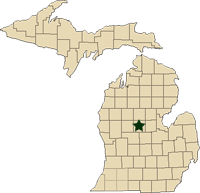Regional reports on Michigan field crops – August 25, 2011
MSU Extension educators’ pest and field crop updates for Michigan.
This weeks regional reports:
- West Central Michigan – Fred Springborn
- Southwest Michigan – Bruce Mackellar
- Central Michigan – Paul Gross
West Central Michigan – Fred Springborn, Michigan State University Extension
|
Weather
Over the past two weeks we have had temperatures in the mid-70s to low 80s, with lows dropping down into the 50s. Rainfall has been variable with many areas receiving 0.75 to 1 inch in the last week. Soil moisture is generally very adequate for crop growth in all areas.
Crop reports
Corn is highly variable with many fields in early dent and several fields just past blister stage. Some fields are showing the results of fair to less than ideal pollination conditions earlier this year, with many ears not filled at the tip, butt or both.
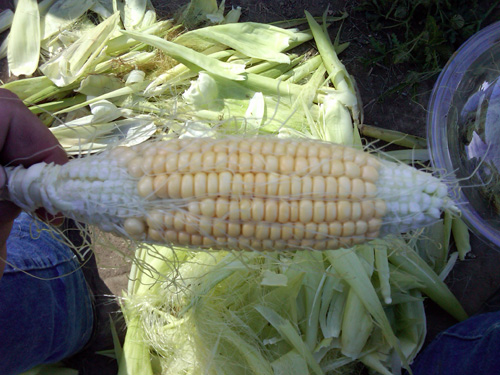
Poor pollination.
Western bean cutworm is present in many fields and feeding on ears. The majority of the larvae present are in late stages (4th to 5th instar) and will begin dropping to the soil in the next couple of weeks to enter their prepupal overwintering stage. Corn earworm is also present and feeding on ears in many fields. Now is an excellent time to walk corn fields to observe ear damage, identify the insect responsible and to begin estimating yield potential.
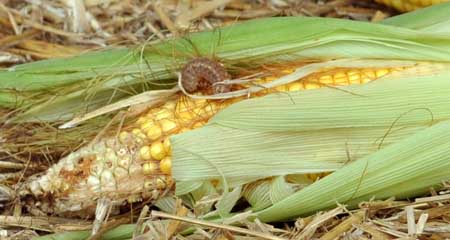
Western bean cutworm on ear. Photo credit: Mallory Fournier, MSU IPM Program.
Soybeans are filling pods in most fields. Japanese beetles continue to be the primary leaf feeder in the Montcalm area and bean leaf beetle is feeding in many other areas around the region. Damage is below threshold in the vast majority of fields. It is important to remember that the defoliation threshold is for the entire plant, not just the top leaves.
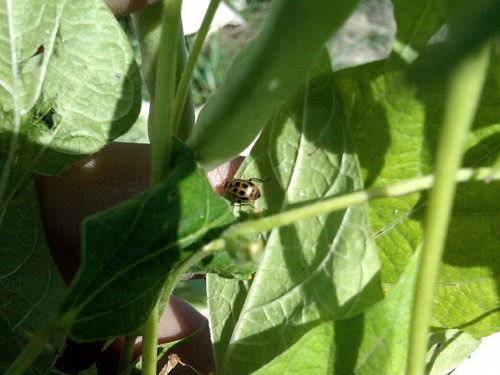
Bean leaf beetle.
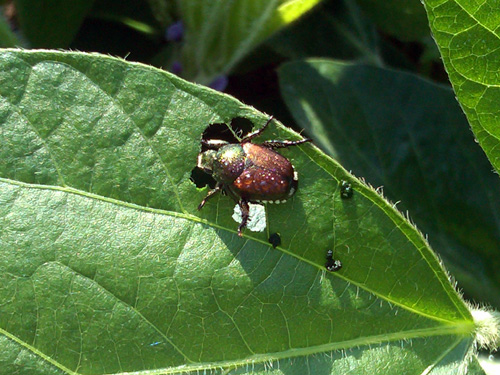
Japanese beetle feeding on soybean.
Dry beans, like many other crops, are variable. Many early planted fields struggled to set and retain pods and later-planted fields will need continued warm weather to mature. Japanese beetles and bean leaf beetles are feeding on the upper foliage in many fields. Western bean cutworm feeding damage is showing up in some unsprayed areas of fields in the high pressure areas.
Southwest Michigan - Bruce MacKellar, Michigan State University Extension
|
Weather
A cold front dropping through the region on the evening of August 24 triggered a series of strong thunderstorms across southern Kalamazoo, St. Joseph and Cass counties and points east, producing high winds, heavy rainfall and occasional hail as the storms moved eastward. While the period was a little drier than some over the summer, we still saw enough rainfall to provide crops with enough moisture to recover from a bit of late season drought stress. Most areas underwent a period of drought stress over the last two weeks.
Temperatures
As we move towards the end of August, GDD accumulations across the region have been very favorable, especially considering the slow start to the growing season. We have averaged from 1977 to 2219 GDD’s Base 50 since May 1, depending upon the proximity to Lake Michigan, with an average of 2113 for the 12 Enviro-weather stations in the southwestern portion of the region. These totals continue to keep us above the long term average, which is normally around 1976 (which remains about five to six hot summer days ahead of normal). The average GDD accumulation Base 50 in the region for the next five days is 20.4, and the following five days is 19.6.
The 6-to-10 and 8-to-14 day outlooks both predict a return of the hot weather. The southwest region is solidly in the above normal temperature range for this period. As long as we can maintain favorable soil moisture levels, this should help our late planted crops to continue to grow well.
Rainfall
Rainfall totals since August 11 range between 0.43 inches in Berrien Springs, Mich., and 3.3 inches in South Haven, Mich. The average precipitation total for the 12 Enviro-weather stations during this period was 1.5 inches. Rainfall for the normally dry month of August across the region has ranged from 1.53 in Berrien Springs to 5.4 in South Haven. The 6-to-10 day outlook has the region in the below normal precipitation range, with a return to more seasonal rainfall totals in the 8-to-14 day outlook.
Crops
We are getting to the time of year that we should be thinking about when to stop alfalfa harvest to allow the plants to move enough carbohydrate reserves to the roots to maintain stand life and vigor of next year’s first cutting. That actual date will vary depending upon the expected first frost date and proximity to Lake Michigan. We are also approaching the period where we should wrap up late summer alfalfa seedings to allow enough time for tap roots to develop and prevent unacceptable winter injury.
The early planted corn in the region is in the dent stage. Fields that were planted in mid- to late June have moved well into the dough stages. The later planted corn may have seen less stress than most of the corn planted in the first week of May. Overall, the crop is progressing very well. The expected warmer conditions should really help to finish up the corn and start the dry-down process in good shape.
Seed corn maturity is pretty much all over the board, depending upon when it was planted. We still are working on male row destruction in later planted fields. Some of the earliest planted fields are nearing the harvest window.
|
Most early planted soybean fields are in R6. Early planted short maturity beans have begun to senesce. Recent rainfall should be very beneficial in helping size the beans in the pods. Heat and drought stress in the R1 to R3 stages may have dinged yields here a bit from grower’s early expectations. We can find white mold in irrigated fields, but generally it has been less of an issue this year compared to normal. Sudden death syndrome (SDS) can be found in areas, particularly those areas in fields where soybean cyst nematodes have been heavy in the past. We should continue to monitor for soybean aphids and spider mites in areas where soybeans were planted late, particularly in southern Berrien, Ottawa and Allegan counties.
Soybean growers should take advantage of the period about one to two weeks before senescence to scout areas in fields exhibiting premature yellowing or leaf drop. These areas are often great indicators of nematode, insect or disease challenges. Look for classic symptoms, leaf yellowing with interveinal necrosis, or leaflet drop with petioles (leaf stems) still attached to the plant as a symptom of SDS. You should also investigate the roots for signs of soybean cyst nematodes. Investigating areas of trouble in the fields can give you a heads up for what sort of soybean varietal resistance you should be looking for when you purchase seed for the field the next time. If our SDS research near Decatur has taught us one thing, the more you know about the disease pressure in your fields, the more ability you have to select soybean varieties that will perform well in your fields.
Central Michigan - Paul Gross, Michigan State University Extension
|
|
Weather
The weather in July had most farmers wishing for a little less heat and more rain. In August, the table is turned with adequate rainfall and farmers hoping for more heat as the temperatures cool and the days become shorter. Most areas of the region received over 1 inch of rain over the past two weeks. Growing degree day totals are near normal, but with the later planted crops in most areas, above average heat will be needed to mature the crop.
Commodity reports
The corn crop is beginning to dent in most of the region. In the north where planting was not delayed, the early planted fields are in the dough stage. Most farmers feel there is an average crop in the field, but we will need a long, warm September to dry this crop down. There are a few farmers that have been chopping corn silage out of need. There are reports that the crop is surprisingly dry, with moisture in the low 70s. Farmers that will be making corn silage are advised to monitor whole plant moisture so the crop does not get to dry for quality silage.
The soybean crop has enjoyed the August rains. The saying that the soybean crop is made in August has farmers feeling good about the yield potential. Many feel we have an above average crop in the field. There is evidence that some of the early planted fields have lost some of the pods on the first few nodes due to heat stress during flowering. It appears they will make up for the lost pods with good pods set on the upper nodes. We are still seeing some leaf feeding from grasshoppers. No other problems have been reported.
Harvest of third cutting alfalfa is complete. Most are reporting good yields. Hay growers are reminded to review their fall cutting schedule and allow for adequate regrowth before the alfalfa goes into dormancy. This will be important for good winter survival. New summer seeding are doing very well with adequate rains.
This is a good time to make some improvements in the harvested wheat fields. This could include cover crops, drainage tile or liming. Farmers are encouraged to manage weeds in these fields.
The dry bean crop is beginning to mature. There is concern with yield potential with all the heat during flowering. Most dry bean growers are reporting a low number of pods on most plants. Harvest is expected to begin shortly after Labor Day (September 5) in early planted fields.



 Print
Print Email
Email